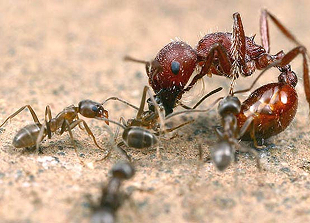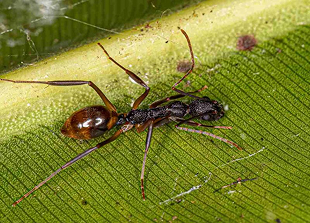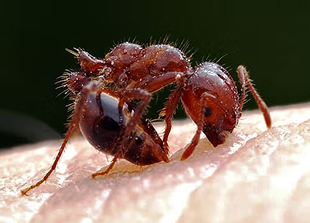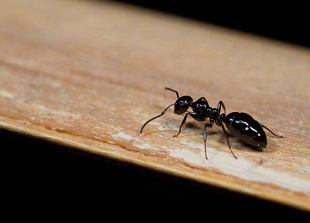Ant Control & Removal Services
Primary Types of Ants in Southern California

Argentine Ants

Odorous Ants

Red Imported Fire Ants

Little Black Ants
Two main types of ants we deal with in California
Argentine
Appearance
Light to dark brown in color, ranging in size from 1.6 to 2.8 millimeters in length. Argentine ants are known for their trail-building behavior, often forming long trails between their nest sites and food sources. They are highly adaptable and can establish extensive colonies, often containing multiple queens. Argentine ants are also aggressive towards other ant species, making them a dominant presence in many areas where they are introduced.
Life Cycle
Egg→ Larvae→ Pupae→ Adult
At the egg stage, the queen ants lay tiny, oval-shaped, and usually white or translucent eggs within the safety of the colony. Once hatched, they give rise to larval ants which are entirely dependent on the adult worker ants for food and care. During this stage, larvae undergo rapid growth and development, molting several times as they increase in size. Once larval development is complete, they enter the pupal stage. They will then undergo metamorphosis, transforming into adult ants with their legs, antennae, and other adult characteristics.
Diet
Argentine ants will feed on just about anything from dead animals (including insects) to all kinds of human and pet food. A favorite food of this ant is the honeydew produced by insects like aphids, mealybugs, scales, and whiteflies. Plants that harbor these pests and are growing near a structure will attract ants to the building. Adult ants will always feed on sugary liquids and will share the food they forage with the rest of the colony in a process called trophallaxis. Trophallaxis is when insects exchange regurgitated liquid contents with each other.
Habitat
Argentine ants will most often establish their colonies in dry soil in or around structures like homes, walls, sidewalks, plants, trees, etc. They can also nest in unexpected areas like indoor potted plants or electrical boxes.
Little Black Ants
Appearance
As their name suggests, little black ants are uniformly dark in color, ranging from deep brown to black. They are among the smallest ant species, with workers typically ranging from 1 to 2 millimeters in length. Little black ant winged swarms are common from June to August, during which time mating occurs. These swarmers can often be mistaken for termites.
Life Cycle
At the egg stage, multiple queen ants lay tiny, oval-shaped, and usually white or translucent eggs within the safety of the colony. Once hatched, they give rise to larval ants which are entirely dependent on the adult worker ants for food and care. During this stage, larvae undergo rapid growth and development, molting several times as they increase in size. Once larval development is complete, they enter the pupal stage. They will then undergo metamorphosis, transforming into adult ants with their legs, antennae, and other adult characteristics.adult characteristics.
Diet
Little black ants feed on a variety of sugars and proteins including candy, fruit, honeydew, nectar, pollen, insects, oils, corn meal, and meats. Little black ants will always go after sugary liquids and will share the food they forage with the rest of the colony in a process called trophallaxis. Trophallaxis is when insects exchange regurgitated liquid contents with each other.
Habitat
Little black ants typically favor outdoor habitats, where they construct their nests within cracks in walls or cement, and underneath landscaping paper. Indoors, they may create nests within voids and cavities, often in inaccessible locations such as within walls.
Key Takeaways and Control Methods
The presence of ants in homes can be frustrating and unsanitary. Here are some effective ways to manage and prevent ant infestations:
Seasonal Surge
Ant invasions during summer are not mere coincidence but a result of favorable environmental conditions that accelerate their life cycle. Factors like temperature, humidity, and food availability contribute to their drastic population increase.
Winter Ant Control
Controlling ant populations during winter is critical for minimizing summer infestations. By addressing ant colonies during the colder months, we can effectively limit their numbers and mitigate future infestation.
Strategic Treatment
Leveraging ant behaviors like trophallaxis—the sharing of food within the colony—offers a strategic advantage in treating inaccessible infestations. Special baits mixed with sugary liquid can penetrate deep into colonies, effectively managing difficult-to-reach populations.
Eliminate Food Sources
Keep food sealed, clean up spills immediately, and remove pet food when not in use to reduce attractants.
Address Moisture Issues
Repair leaks, eliminate standing water, and improve ventilation to discourage ants from nesting.
Seal Entry Points
Close cracks, gaps, and openings around windows, doors, and foundations to prevent ants from entering.
Maintain Outdoor Spaces
Trim vegetation away from the home and remove debris where ants may establish nests.
Professional Pest Control
Targeted treatments and ongoing pest management can effectively reduce ant populations and prevent infestations.
If ants are invading your home or business in Orange County, we are here to help. We offer customized treatments to tackle infestations at the source and provide long-term solutions for ant prevention. Contact us today for an inspection and keep your property ant-free!
our services
Simple Solutions To Complex Problems at an Affordable Rate

Residential
We offer a variety of plans custom fit for your needs! Whether its an endless trail of ants, or strange noises in the walls, we’ve got your pest control needs covered!

Commercial
We can stop pests from causing costly machinery repairs, fines, closures, and damage to your reputation!

rodents
Various species of rats and mice inhabit the Orange County area. Remove rodents from your home permanently with our exclusion services.

mosquito
We use the In2Care system to eliminate mosquitoes where they breed—protecting your family’s health and comfort.

